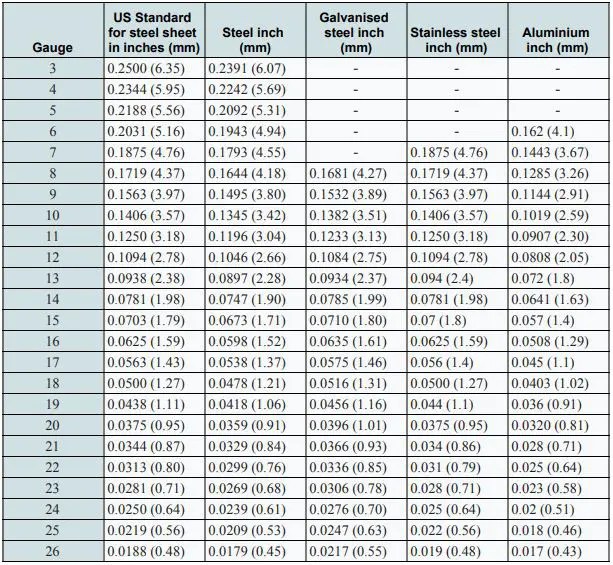Sheet Steel Thickness
Sheet Steel Thickness - Master the art of selecting the perfect metal thickness for your fabrication projects This thickness is measured in either mm or in thousandths of an inch (in). Steel stainless steel aluminum, brass, etc. Web for ferrous and nonferrous metals. Web sheet metal gauge thickness chart. Web the table below provides sheet steel weights and thicknesses in both us and metric according to the manufacturers’ standard gauge for sheet steel (msg), which is the primary commercial gauge system used by sheet.
This thickness is measured in either mm or in thousandths of an inch (in). Processing may include polishing, or the applying of protective plastics which will decrease or increase a sheet’s thickness respectively. Anything thicker 6 millimetres is classified as metal plate, and anything. Web the table below provides sheet steel weights and thicknesses in both us and metric according to the manufacturers’ standard gauge for sheet steel (msg), which is the primary commercial gauge system used by sheet. By providing a standardized measurement system, it allows users to quickly determine the thickness based on gauge numbers.
When working with sheet metal, the term “gauge” is often used. Web sheet metal gauge thickness chart ( to mm/inch comversation) standard steel. Web sheet metal gauge & thickness for ferrous and nonferrous metals thickness† ferrous metals nonferrous metals gauge no. Anything thicker 6 millimetres is classified as metal plate, and anything. Sheet metal thickness in mm. The higher the gauge, the thinner the sheet metal (except for zinc).
Web the table below provides sheet steel weights and thicknesses in both us and metric according to the manufacturers’ standard gauge for sheet steel (msg), which is the primary commercial gauge system used by sheet. Web sheet metal gauge & thickness for ferrous and nonferrous metals thickness† ferrous metals nonferrous metals gauge no. Inches (mm) inches (mm) inches (mm) inches (mm) 26.
The Gauge System, Widely Used In Metal Fabrication, Provides A Standardized Method For Specifying Sheet Metal Thickness.
Gauge are used to specify the thickness of a metal sheet. Web use this resource to learn about sheet metal gauges and explore sheet metal thickness charts. How to measure sheet metal gauge thickness? For example, 18 gauge steel, according to a gauge conversion chart, is 0.0478 inch or 1.214 millimeter.
Web The Chart Below Can Be Used To Determine The Equivalent Sheet Thickness, In Inches Or Millimeters, For A Gauge Number From The Selected Gauge Size Standard.
Inches (mm) inches (mm) inches (mm) inches (mm) 26. The higher the number, the thinner the sheet metal. Web sheet metal gauge & thickness for ferrous and nonferrous metals thickness† ferrous metals nonferrous metals gauge no. Processing may include polishing, or the applying of protective plastics which will decrease or increase a sheet’s thickness respectively.
When Working With Sheet Metal, The Term “Gauge” Is Often Used.
In australia, the typical thickness of sheet metal is between 0.5 millimetres and 6 millimetres. The gauge size for each type of material differs and is determined by weight. The higher the gauge, the thinner the sheet metal (except for zinc). Web this comprehensive chart illustrates the correlation between gauge numbers and the corresponding thickness of steel sheets in both imperial (inches) and metric (millimeters) units.
The Weight Per Unit Area Of The Sheet Can Also Be Seen In Pounds Per.
Sheet metal thickness in mm. What is the thickest and thinnest gauge of sheet metal? Steel stainless steel aluminum, brass, etc. A sheet metal gauge tool is used to measure metal thickness and shows both the gauge number as well as the thickness of the metal in thousandths.




